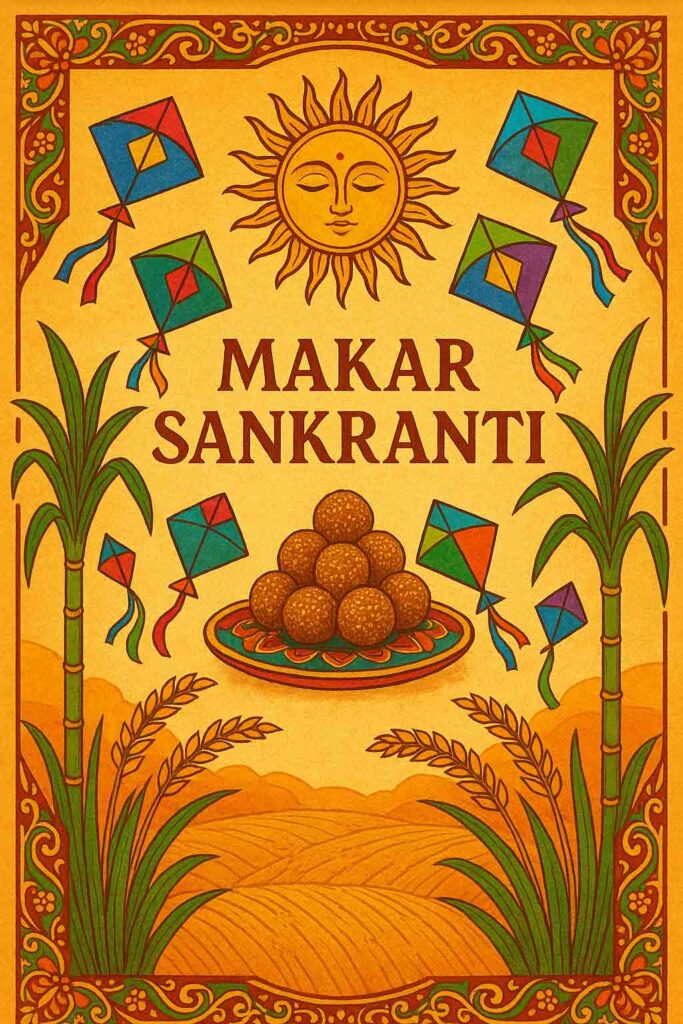Makar Sankranti (January 14)
The Festival of Sun, Harvest, and New Beginnings

Makar Sankranti, one of India’s most ancient and widely celebrated festivals, marks the transition of the Sun into the zodiac sign of Makara (Capricorn) and signifies the end of the winter solstice. This celestial event, usually occurring on January 14th each year, heralds longer and warmer days, symbolizing hope, prosperity, and the renewal of life. It is among the few Indian festivals that follow the solar calendar, which is why its date remains constant, unlike other festivals that shift according to the lunar calendar. Across the country, Makar Sankranti is celebrated with different names, customs, and traditions, but its underlying spirit—gratitude for nature’s bounty and the celebration of the harvest—remains universal.
The festival holds deep agricultural significance. It marks the time when farmers rejoice after months of hard work during the harvest season. The granaries are full, and the land, having yielded its produce, becomes a symbol of abundance and sustenance. People express their gratitude to the Sun God (Surya Dev), whose warmth and light are essential for growth and life. In rural India, Makar Sankranti is closely tied to nature’s rhythms; it is a day when farmers rest, celebrate, and pray for good harvests in the coming year. Offerings of the first crops—especially newly harvested grains, sugarcane, sesame (til), and jaggery (gur)—are made in rituals, highlighting the deep bond between human life and the natural world.
Each region in India celebrates Makar Sankranti with its own distinctive flavor and traditions. In North India, particularly in Punjab and Haryana, it coincides with Lohri, a festival of bonfires, dance, and song. People gather around the fire, throwing puffed rice, popcorn, and sesame into the flames as offerings, symbolizing the burning away of the old and the welcoming of new beginnings. In Gujarat and Rajasthan, the sky becomes a canvas of vibrant colors as people engage in kite flying, a hallmark of the festival. The kites, soaring high against the blue sky, represent freedom, joy, and human aspirations reaching toward the heavens. The International Kite Festival in Ahmedabad is a spectacular sight, attracting participants from across the globe.
In Maharashtra, Makar Sankranti is marked by the exchange of sweets made of sesame seeds and jaggery, accompanied by the saying, “Tilgul ghya, goad goad bola,” which means “Accept this sweet and speak sweetly.” This gesture symbolizes the need to forget past grievances and embrace kindness and harmony in relationships. In Tamil Nadu, the festival is celebrated as Pongal, a four-day thanksgiving festival dedicated to the Sun God, cattle, and the Earth. Homes are decorated with kolams (rangoli designs), and rice is cooked in earthen pots until it overflows—a ritual that signifies abundance and prosperity. In Assam, it takes the form of Bhogali Bihu, characterized by feasting, traditional games, and community bonfires, while in Bengal, devotees take holy dips in the Ganges and offer prayers to the rising sun during Gangasagar Mela.
The symbolism of Makar Sankranti extends beyond harvest and celestial transitions; it embodies themes of renewal, light, and self-reflection. As the sun begins its northward journey (Uttarayan), the festival encourages people to turn toward positivity, learning, and growth. The movement from darkness to light mirrors the inner spiritual journey—rising above ignorance and embracing knowledge and wisdom. Traditionally, taking a holy dip in rivers like the Ganga, Yamuna, or Godavari is believed to cleanse sins and purify the soul. The act of charity (daan), especially of food, clothes, and money to the poor, is also an essential part of the celebration, signifying compassion and social responsibility.
Makar Sankranti thus serves as a reminder of the timeless connection between humans and the cosmos, between effort and reward, and between gratitude and generosity. It brings families and communities together in joy, reflection, and thanksgiving. The sight of colorful kites dancing in the sky, the warmth of sesame sweets, the rhythm of folk songs, and the laughter that fills the air all echo a single message—the end of darkness and the dawn of light. Beyond rituals and traditions, Makar Sankranti inspires us to rise higher, stay grounded in gratitude, and celebrate life’s simple yet profound cycles with a heart full of hope and positivity.
